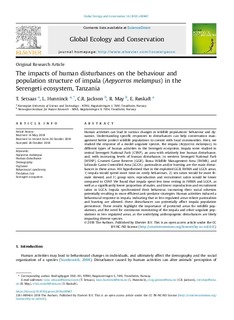| dc.description.abstract | Human activities can lead to various changes in wildlife populations’ behaviour and dynamics. Understanding specific responses to disturbances can help conservation management better protect wildlife populations to coexist with local communities. Here, we studied the response of a model ungulate species, the impala (Aepyceros melampus), to different types of human activities in the Serengeti ecosystem. Impala were studied in central Serengeti National Park (CSNP), an area with relatively low human disturbance, and, with increasing levels of human disturbance, in western Serengeti National Park (WSNP), Grumeti Game Reserve (GGR), Ikona Wildlife Management Area (IWMA), and Loliondo Game Controlled Area (LGCA); pastoralism and/or hunting are the main disturbances in these areas. We hypothesised that in the exploited GGR, IWMA and LGCA areas, 1) impala would spend more time on costly behaviours, 2) sex ratios would be more female skewed, and 3) group sizes, reproduction and recruitment ratios would be lower compared to CSNP. We found that impala spent less time resting in IWMA and LGCA, as well as a significantly lower proportion of males, and lower reproduction and recruitment ratios in LGCA. Impala synchronized their behaviour, increasing their social cohesion potentially resulting in more efficient anti-predator strategies. Human activities induced a behavioural response in impala, indicating that in less regulated areas where pastoralism and hunting are allowed, these disturbances can potentially affect impala population persistence. These results highlight the importance of protected areas for wildlife populations, and the need for continuous monitoring of the impala and other ungulate populations in less regulated areas, as the underlying anthropogenic disturbances are likely impacting diverse species. | nb_NO |

